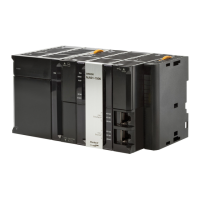6 Inspection and Maintenance
6-2
NJ-series CPU Unit Hardware User’s Manual (W500)
6-1 Periodic Maintenance and Inspection
Daily or periodic inspections are required in order to maintain the Controller's functions in peak operat-
ing condition.
Although the major components in NJ-series Controllers have an extremely long life time, they can
deteriorate under improper environmental conditions. Periodic inspections are thus required to ensure
that the required conditions are being kept.
Inspection is recommended at least once every six months to a year, but more frequent inspections will
be necessary in adverse environments.
Take immediate steps to correct the situation if any of the conditions in the following table are not met.
6-1-1 Periodic Inspection
Periodic Inspection Points
No. Item Inspection Criteria Action
1 Source Power
Supply
Check for voltage fluctua-
tions at the power supply ter-
minals.
The voltage must be within
the allowable voltage fluctua-
tion range.
85 to 264 VAC (+10%/15%)
Use a voltage tester to check the
power supply at the terminals. Take
necessary steps to bring voltage
fluctuations within limits.
2 I/O Power Supply Check for voltage fluctua-
tions at the I/O terminals.
Voltages must be within
specifications for each Unit.
Use a voltage tester to check the
I/O power supply at the terminals.
Take necessary steps to bring volt-
age fluctuations within limits.
3 Ambient environ-
ment
Check the ambient tempera-
ture. (Inside the control panel
if the Controller is in a control
panel.)
0 to 55C Use a thermometer to check the
temperature and ensure that the
ambient temperature remains
within the allowed range of 0 to
55C.
Check the ambient humidity.
(Inside the control panel if
the Controller is in a control
panel.)
Relative humidity must be
10% to 90% with no conden-
sation.
Use a hygrometer to check the
humidity and ensure that the ambi-
ent humidity remains between 10%
and 90%. Make sure that conden-
sation does not occur due to rapid
changes in temperature.
Check that the Controller is
not in direct sunlight.
Not in direct sunlight Protect the Controller if necessary.
Check for accumulation of
dirt, dust, salt, metal pow-
der, etc.
No accumulation Clean and protect the Controller if
necessary.
Check for water, oil, or
chemical sprays hitting the
Controller.
No spray Clean and protect the Controller if
necessary.
Check for corrosive or flam-
mable gases in the area of
the Controller.
No corrosive or flammable
gases
Check by smell or use a sensor.
Check the level of vibration
or shock.
Vibration resistance and
shock resistance must be
within specifications.
Install cushioning or shock absorb-
ing equipment if necessary.
Check for noise sources
near the Controller.
No significant noise sources Either separate the Controller and
noise source or protect the Control-
ler.

